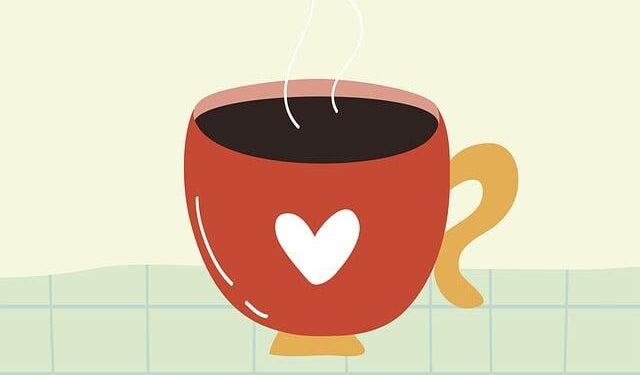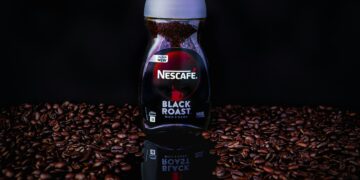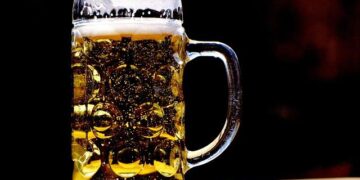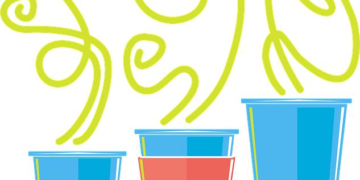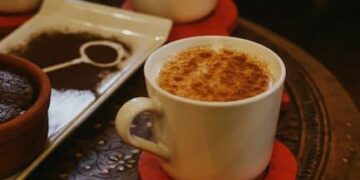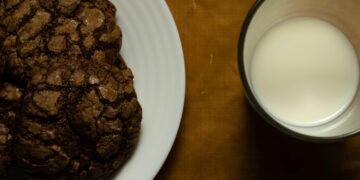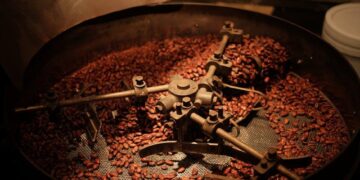Table of Contents
The Comfort of the Cup
The ritual was the anchor of the morning.
It wasn’t just about the caffeine; it was a sensory ceremony that signaled a brief pause before the day’s chaos truly began.
There was the satisfying clink of ice cubes tumbling into the clear plastic cup, the rich, dark swirl of espresso cascading into a creamy abyss of milk, and finally, the hypnotic dance of caramel vanilla syrup weaving its way through the mixture.
The aroma alone—a sweet, buttery promise of energy and indulgence—was enough to justify the daily pilgrimage to the drive-thru.
That first sip was a moment of pure, unadulterated comfort, a reliable pick-me-up that felt less like a choice and more like a necessity.
It was a reward for waking up, a crutch to lean on during a stressful commute, and a non-negotiable part of a routine that felt utterly immutable.
Yet, a quiet dissonance had begun to surface.
This daily “treat” was part of a life that was, by all other measures, healthy.
There were salads for lunch, regular workouts, and a conscious effort to stay hydrated.
Still, a persistent afternoon fog would descend without fail, a heavy-lidded crash that no amount of water could seem to fix.1
A few stubborn pounds clung on, defiant against every other wellness effort.
And then there was the subtle, nagging feeling of being on autopilot, of being pulled by a craving rather than being in control of a choice.2
A cursory glance at a monthly bank statement delivered the final, quiet shock.
The line item for the coffee shop wasn’t just a small indulgence; it was a significant, recurring expense, a hidden fee levied against a future that felt increasingly distant.4
The comfort of the cup had begun to feel like a costly compromise.
The daily ritual, once a source of simple pleasure, was now the starting point of a journey—a deep dive into the nutritional, psychological, and financial truths hiding just beyond the swirl.
Part I: The Anatomy of a Habit: Deconstructing My Daily “Treat”
The transition from a vague sense of unease to a clear-eyed investigation began with a single, deliberate action: looking up the nutritional information for the standard order.
It was a moment of confronting the objective data behind the subjective feeling that something was amiss.
This act of pulling back the curtain revealed a complex interplay of biology, psychology, and economics that had quietly conspired to turn a simple coffee into a powerful, multifaceted habit.
The Sugar Shock in a 24-Ounce Cup
The first step in the epiphany was confronting the stark, unambiguous numbers.
The go-to order, a Medium Dunkin’ Caramel Craze Iced Latte made with whole milk, was not just a beverage; it was a significant metabolic event.
A single 24-fluid-ounce serving contains a formidable 410 calories and 14 grams of total fat, of which 8 grams are saturated fat—40% of the recommended daily value.6
But the most startling figure was the sugar content.
The drink packs a staggering 61 grams of total carbohydrates, with 57 grams of that being total sugars.
Critically, 39 grams of that sugar are “added sugars,” the kind intentionally put in for sweetness rather than occurring naturally in the ingredients.6
To put this into perspective, the American Heart Association (AHA) recommends a daily limit of no more than 25 grams of added sugar for most women and 36 grams for most men.8
The World Health Organization (WHO) is even more conservative, suggesting a limit of 25 grams for the average adult.9
This one medium-sized coffee, often consumed as a morning kick-starter, not only meets but dramatically exceeds the entire recommended daily allowance of added sugar.
It’s more sugar than a 12-ounce can of Coca-Cola, which contains about 38 grams.11
This realization forces a crucial psychological reframing.
The beverage, long considered a “coffee,” is more accurately categorized as a liquid dessert.
Its nutritional profile rivals, and in many cases surpasses, that of traditional sweets.
Some of the most indulgent frozen coffee drinks on the market contain over 100 grams of sugar in a single serving, making them more akin to a slice of cake or a milkshake than a caffeinated beverage.12
The physical cost of this indulgence is equally sobering.
To burn off the 410 calories from that one drink would require a significant physical effort, such as approximately 62 minutes of continuous weight training or a grueling 22 minutes of running up and down stairs.6
The ease of consumption stands in stark contrast to the difficulty of its metabolic expenditure.
This disconnect is amplified by what can be described as a “health halo” effect surrounding coffee.
Consumers generally associate coffee with positive health outcomes, such as its rich antioxidant content and potential to reduce the risk of certain diseases.14
The term “latte” itself evokes a relatively benign image of espresso and steamed milk.
A standard, unsweetened Grande Caffè Latte from Starbucks, for instance, contains a modest 190 calories and 18 grams of sugar, all of which are naturally occurring from the milk.16
However, the branding of products like the “Caramel Craze Iced Latte” cleverly leverages these positive associations.
The addition of the “Caramel Craze” components—syrupy swirls often made with sweetened condensed milk, sugar, and high-fructose corn syrup—fundamentally transforms the drink.17
The marketing terminology preys on the consumer’s perception of “coffee” and “latte” as healthy choices, effectively masking the reality that they are purchasing a high-calorie, high-sugar product.
The problem is not the coffee itself, but the cascade of hidden, sugar-laden additions that are not transparently communicated to the consumer.19
The Craving Cycle: Why It’s So Hard to Stop
Understanding the nutritional data is one thing; understanding the powerful, almost magnetic pull of the habit is another.
The difficulty in forgoing the daily sweet coffee is not a matter of weak willpower but a complex dance of neurochemistry and psychology.
The human brain is hardwired to seek out rewards, and sugar is one of the most potent rewards it can encounter.
When consumed, sugar triggers the release of dopamine, a neurotransmitter associated with pleasure and motivation, in the brain’s reward system.
This is the very same neural pathway activated by addictive substances.1
The brain registers the sugary coffee as a profoundly positive event, reinforcing the desire to repeat the behavior and experience that “feel-good” sensation again and again.1
This neurological reward system is compounded by a physiological rollercoaster.
The massive dose of simple carbohydrates and added sugars in a drink like the Caramel Craze Latte causes a rapid and dramatic spike in blood glucose levels.24
In response, the pancreas releases a surge of the hormone insulin to shuttle this sugar out of the bloodstream and into the body’s cells for energy.
The result is an equally rapid drop in blood sugar, often referred to as a “crash.” This leaves one feeling depleted, shaky, fatigued, and irritable—the very afternoon fog that prompted this investigation in the first place.1
In this state of low energy, the brain instinctively seeks the quickest possible source of fuel to regain the “high,” which is, of course, more sugar.
This creates a vicious, self-perpetuating cycle of craving and consumption.1
This biological dependency is deeply intertwined with psychological and environmental triggers.
Stress, for example, is a powerful driver of sugar cravings.
It increases the body’s production of ghrelin, the “hunger hormone,” which stimulates appetite, while simultaneously lowering levels of serotonin, a neurotransmitter that helps regulate mood.3
In this state, the brain craves the quick mood-boost that sugar’s dopamine release provides, making the sweet coffee an effective, albeit temporary, form of self-medication for anxiety, frustration, or even boredom.2
Similarly, poor sleep habits can sabotage even the best intentions.
A lack of adequate sleep impairs the function of the cerebrum, the part of the brain responsible for executive functions like self-control, while also disrupting the balance of appetite-regulating hormones.
This leaves a person chemically disadvantaged, with intense cravings for the quick energy that sugar provides.3
Ultimately, the daily coffee habit is not the core problem but a symptom of a broader imbalance in one’s life.
The craving for a sweet, comforting drink is often a “socially acceptable smokescreen” for a deeper, unmet psychological need.2
It can be a substitute for genuine stress relief, a reward in the absence of other forms of self-care, or a way to numb uncomfortable emotions.
This realization shifts the entire framework of the problem.
The solution cannot simply be to “drink less sugar.” A truly effective and sustainable solution must also address the root causes—developing healthier coping mechanisms for stress, prioritizing sleep, and finding fulfilling, non-food-based ways to experience pleasure and reward.
The coffee habit is a signal that “sweetness” is craved in another, more fundamental part of life.2
The Hidden Financial Drain
The final piece of the puzzle was understanding the financial implications of this daily ritual.
While the nutritional cost was hidden in complex labels and the psychological cost was masked by habit, the financial cost was plainly visible on bank statements, yet often ignored.
Applying a basic budgeting framework, such as the popular 50/30/20 rule—where 50% of after-tax income goes to needs, 30% to wants, and 20% to savings and debt repayment—provides a clear lens through which to evaluate this expense.4
A simple calculation reveals the staggering cumulative impact of a seemingly small daily purchase.
A $5 coffee, five days a week, amounts to $25 per week.
This translates to approximately $100 per month and a significant $1,200 per year.5
This single “want” can easily consume a substantial portion of one’s discretionary spending budget, crowding out other potential uses for that money.
This phenomenon, often called the “latte factor,” can be thought of as a hidden fee on one’s life goals.
In the world of investing, financial advisors warn about the corrosive effect of seemingly small annual fees, which compound over time and dramatically erode the potential returns of a portfolio.26
The daily coffee habit functions in precisely the same Way. The small, daily expense compounds over months and years, eroding the ability to build an emergency fund, save for a vacation, pay down high-interest debt, or invest for retirement.29
Each cup purchased is, in essence, a “surrender charge” paid against future financial security and freedom.
It is a daily, voluntary tax on one’s own aspirations.
Part II: The Epiphany in Black and White
Armed with the initial, shocking data about the default daily order, the investigation deepened.
The feeling of being a helpless victim of cravings began to recede, replaced by a sense of empowerment that comes from knowledge.
The turning point was the realization that the daily coffee was not a single, monolithic choice, but a constellation of variables—brand, size, milk, syrups—each with its own distinct nutritional consequence.
The epiphany was not in the problem, but in the vast, previously unseen landscape of potential solutions.
A Tale of Two Coffees: The Nutritional Showdown
The power of comparison is the power of perspective.
Placing different coffee configurations side-by-side reveals the dramatic impact of small choices.
A key discovery is that not all coffee chains are created equal.
While a medium (24 fl oz) Dunkin’ Caramel Craze Iced Latte with whole milk contains 410 calories and 57 grams of sugar, a comparable Grande (16 fl oz) Starbucks Iced Caramel Macchiato with standard 2% milk has a significantly lower 250 calories and 34 grams of sugar.6
This difference alone highlights that brand choice and default recipes play a major role in the nutritional load.
The choice of milk is another critical variable.
Simply switching from whole milk to skim milk in the medium Dunkin’ Caramel Craze Latte reduces the calorie count from 410 to 340 and slashes the total fat from 14 grams to just 5 grams.7
The impact is even more pronounced when considering plant-based alternatives.
While precise data for every combination requires using online calculators, extrapolating from available information shows that a Grande Starbucks Iced Caramel Macchiato made with almond milk would likely fall in the range of 190-200 calories, a substantial reduction from the 250 calories with 2% milk.32
Finally, the seemingly innocuous act of “upsizing” has an exponential effect on the nutritional cost.
Moving from a small Dunkin’ Caramel Craze with skim milk (250 calories, 40g sugar) to a large with whole milk catapults the drink into another stratosphere: 530 calories and a shocking 74 grams of sugar.34
This is nearly double the calories and almost double the sugar, a disproportionate increase for a marginal increase in volume.
The following table illustrates this nutritional landscape, providing the “epiphany” in clear, black-and-white data.
Table 1: The Nutritional Showdown: Deconstructing Your Caramel Iced Coffee
| Brand | Drink Name & Milk Type | Size | Calories | Total Fat (g) | Saturated Fat (g) | Total Carbs (g) | Total Sugars (g) | Added Sugars (g) | Source(s) |
| Dunkin’ | Caramel Craze Signature Iced Latte w/ Whole Milk | Small (16 oz) | 260 | * | * | * | * | * | 36 |
| Dunkin’ | Caramel Craze Signature Iced Latte w/ Whole Milk | Medium (24 oz) | 410 | 14 | 8 | 61 | 57 | 39 | 6 |
| Dunkin’ | Caramel Craze Signature Iced Latte w/ Whole Milk | Large (32 oz) | 530 | 17 | 10 | 79 | 74 | * | 34 |
| Dunkin’ | Caramel Craze Signature Iced Latte w/ Skim Milk | Small (16 oz) | 250 | 5 | 3 | 43 | 40 | 27 | 35 |
| Dunkin’ | Caramel Craze Signature Iced Latte w/ Skim Milk | Medium (24 oz) | 340 | 5 | * | 61 | * | * | 31 |
| Dunkin’ | Caramel Craze Signature Iced Latte w/ Skim Milk | Large (32 oz) | 430 | 6 | * | 79 | * | * | 38 |
| Starbucks | Iced Caramel Macchiato w/ 2% Milk | Tall (12 oz) | 190 | 5 | 3 | 29 | 27 | * | 39 |
| Starbucks | Iced Caramel Macchiato w/ 2% Milk | Grande (16 oz) | 250 | 7 | 4.5 | 37 | 34 | * | 17 |
| Starbucks | Iced Caramel Macchiato w/ Almond Milk | Venti (24 oz) | 250 | 8 | 2 | 42 | 36 | * | 32 |
| Starbucks | Customized Iced Skinny Macchiato w/ Almond Milk | Venti (24 oz) | 120 | 8 | 2 | 9 | 2 | * | 40 |
Note: Asterisks () denote data not available in the provided sources.
Some values are aggregated from multiple sources providing similar data.
“Skinny” denotes the use of sugar-free syrup.*
This stark comparison shatters the perception of the daily coffee as a single, fixed choice.
It reveals a spectrum of possibilities, from a 530-calorie sugar bomb to a 120-calorie customized beverage.
This transforms the consumer from a passive recipient of a default menu item into an informed architect of their own drink, demonstrating that the problem is not “iced coffee” but a specific, and highly modifiable, configuration of it.
Deconstructing the Drizzle: Unmasking the Culprits
Looking beyond the nutrition facts panel to the ingredient list provides the next layer of revelation.
The “flavor” in these drinks is not an ethereal essence but a tangible concoction of sugar and fat.
The ingredient list for Starbucks’ Caramel Sauce, for example, reads like a recipe for candy: sugar, corn syrup, butter, and heavy cream.17
Their Vanilla Syrup is even simpler: sugar and water.17
This discovery demystifies the drink; its deliciousness is not magic, but a straightforward application of the most basic, hyper-palatable ingredients.
A crucial distinction, particularly for Dunkin’ patrons, lies in the terminology used for flavorings.
The chain offers two types of additions: “swirls” and “shots.” A “swirl,” such as the Caramel Swirl, is a thick, sweetened, cream-based syrup.
Each pump of a swirl adds a significant caloric load, estimated to be around 50-60 calories, and is made with ingredients like sweetened condensed milk.18
In stark contrast, a “flavor shot,” such as the vanilla, hazelnut, or toasted almond options, is unsweetened and contains a negligible number of calories.42
The realization that the default “Caramel Craze” is built on multiple pumps of a high-calorie swirl, rather than a low-calorie shot, is a critical piece of insider knowledge.
This leads to a broader understanding of a “customization paradox.” Coffee chains like Starbucks and Dunkin’ offer a vast array of options for customers to tailor their drinks, from milk choices to the precise number of syrup pumps.44
However, the default, prominently advertised “Signature” drinks are pre-set combinations engineered for maximum flavor and indulgence, not health.6
The healthier alternatives—like swapping swirls for shots or requesting fewer pumps of syrup—are available but are not advertised.
They require a level of “insider” knowledge that the average consumer simply does not possess.42
The system is designed to guide the consumer down the path of least resistance, which also happens to be the unhealthiest path.
The tools for making a better choice are present, but they are obscured by menu design and marketing.
The epiphany, therefore, is not just about the numbers, but about recognizing the need to actively deviate from the default.
The solution requires more than just willpower; it requires learning the “hacks” and “secrets” of the system to navigate it in a way that aligns with one’s own health goals, rather than the company’s sales goals.44
Part III: The Solution – Crafting a Healthier Ritual
The journey from struggle and epiphany culminates in a practical, actionable roadmap.
Armed with a clear understanding of the nutritional, psychological, and financial costs, the protagonist can now move from analysis to implementation.
This final phase is about crafting a new, sustainable routine that preserves the pleasure of the coffee ritual without the detrimental consequences.
It is a shift from being a passive consumer to a conscious creator of one’s own habits.
The Smart Sipper’s Guide to the Coffee Shop
The first step in reclaiming the coffee ritual is learning how to order strategically.
This involves having a clear, concise script ready before even approaching the counter or the drive-thru speaker.
These “hacks,” often shared in online communities, are the key to unlocking the healthier options hidden within the menu.42
A potential new script for Dunkin’ could be: “I’d like a Medium Iced Coffee with almond milk, one pump of caramel swirl, and two pumps of the unsweetened vanilla flavor shot.” This strategy dramatically reduces the sugar and calories from the high-octane swirl by using it sparingly for its caramel flavor, while relying on the zero-calorie unsweetened shots to build the rest of the flavor profile.42
An even simpler, lower-sugar option would be a “Medium Iced Latte with skim milk and just one pump of caramel swirl”.41
At Starbucks, a similar approach works.
Instead of the default, a healthier order could be: “Grande Iced Caffè Latte with almond milk, one pump of vanilla syrup, and light caramel drizzle.” This order deconstructs the high-sugar Macchiato into its core components and reassembles them in a more balanced Way.50
These specific orders are based on a few key principles of smart ordering:
- Go Smaller: Defaulting to the smallest available size (a “Small” at Dunkin’ or a “Tall” at Starbucks) is the single most effective way to manage portion control and immediately reduce the intake of sugar, fat, and calories.14
- Milk Matters: Actively choose lower-fat, lower-sugar milk options. Skim milk, or plant-based alternatives like unsweetened almond or oat milk, are consistently better choices than whole milk or cream.14
- Control the Syrup: Never accept the default number of syrup pumps. A standard “Grande” size often contains 3 or 4 pumps. Specify the number you want, such as one or two, to slash the sugar content. When available, always opt for the sugar-free versions of syrups.39
- Know Your Flavors: At Dunkin’, the distinction is critical: always prioritize unsweetened “shots” over the sugary, dairy-based “swirls” for flavoring your drink.18
- Ditch the Toppings: Politely decline the whipped cream and extra drizzles. These are often pure sugar and fat and add a significant number of empty calories with little nutritional benefit.13
To further empower these choices, it is wise to consult the official nutritional information provided by the companies themselves.
Both Dunkin’ and Starbucks offer comprehensive PDF guides and online nutrition calculators that allow customers to build their drinks virtually and see the nutritional data before they place an order.45
The Home Barista’s Handbook: Deliciously Healthy Alternatives
While smart ordering is a powerful tool for harm reduction, the ultimate solution for both health and wealth is to shift the ritual from the coffee shop to the home kitchen.
Making coffee at home provides complete control over every ingredient and directly addresses the financial drain identified earlier in the journey.
The recipe for a healthy, delicious homemade caramel iced coffee is remarkably simple.
It requires only three core ingredients: chilled coffee (either pre-brewed and cooled or a cold brew concentrate), a quality sugar-free caramel syrup, and a milk of choice.
Unsweetened almond milk is an excellent option as it provides a creamy texture with minimal calories and sugar.56
The process involves little more than combining the chilled coffee, a tablespoon or two of the sugar-free syrup, and a splash of milk over a generous amount of i.e.59
The nutritional and financial payoff for this minimal effort is immense.
A homemade version using these ingredients can contain as few as 50 calories, with only around 4.5 grams of sugar (all naturally occurring from the milk, with zero added sugar).58
The cost per serving plummets from several dollars to mere cents.
The following table starkly illustrates this advantage.
Table 2: The Home-Brew Advantage: A Healthier, Cheaper Cup
| Metric | Coffee Shop (Medium Dunkin’ Caramel Craze w/ Whole Milk) | Homemade Healthy Version |
| Calories | 410 | ~50 |
| Added Sugar (g) | 39 | 0 |
| Cost (Approximate) | $4.50 – $5.50 | $0.50 – $0.75 |
Sources: 6
This comparison provides a powerful incentive to transition the habit from an external purchase to an internal creation.
It represents the final step in the journey, moving from a powerless consumer subject to default menu options to an empowered creator with full control over their health, finances, and daily rituals.
Beyond the Coffee: Rebuilding Your Habits
The final, and perhaps most crucial, part of the solution is to address the underlying psychological architecture of the habit itself.
Lasting change requires more than just new recipes; it requires rebuilding the behavioral patterns that led to the problem in the first place.
The science of habit formation explains that most habits operate on a simple, three-part loop: a Cue (the trigger that initiates the behavior), a Routine (the behavior itself), and a Reward (the benefit gained from the routine).61
To change a habit, one must consciously intervene in this loop.
This can be achieved through several practical, evidence-based strategies:
- Start Small: Attempting to go from a daily large, sugary latte to black coffee overnight is a recipe for failure. The key to sustainable change is to make incremental adjustments. Start by switching from whole milk to skim milk for one week. The next week, reduce the syrup from three pumps to two. These small, manageable steps are less likely to trigger feelings of deprivation and are easier to maintain over the long term.61 Research indicates that it can take, on average, two to three months of consistent practice for a new eating habit to become automatic and feel effortless.63
- Identify Your Cues: Pay close attention to the circumstances surrounding the craving. What is the trigger? Is it the stress of a 3 PM deadline? The boredom of a long commute? The social pressure of seeing colleagues go on a coffee run?.64 Once the cue is identified, a new, healthier routine can be substituted. If the cue is stress, the new routine could be a five-minute walk outside, a brief meditation, or a few deep breathing exercises.3
- Change Your Environment: Make the bad habit more difficult and the good habit easier. This concept, known as increasing “friction” for unwanted behaviors, is a powerful tool. If possible, alter a commute to avoid driving directly past the tempting coffee shop. At the same time, decrease the friction for the desired behavior by keeping a reusable water bottle and healthy, protein-rich snacks readily available at your desk.62
- Plan Ahead: Willpower is a finite resource that is easily depleted when one is hungry or tired.62 To counteract this, plan ahead. Start the day with a breakfast rich in protein and fiber to help stabilize blood sugar and prevent intense cravings later in the day.1 If a social outing to a coffee shop is unavoidable, look at the menu online beforehand and decide on a healthier order in advance, removing the need to make a decision in a moment of temptation.62
- Find New Rewards: A crucial step is to decouple the brain’s association of “reward” with sugar. Celebrate milestones—like a full week of making coffee at home—with non-food treats. This could be purchasing new workout gear, downloading a new album, or simply setting aside time for an enjoyable hobby. This helps retrain the brain’s reward circuitry to value other sources of pleasure.66
Conclusion: Finding the New Sweet Spot
The journey that began with a simple cup of coffee concludes with a profound sense of clarity and control.
The protagonist of this story, who once felt tethered to a daily ritual that was silently undermining their health and finances, now enjoys a new kind of morning ceremony.
The coffee is still there—perhaps a homemade iced latte, lightly sweetened with a sugar-free syrup and made with creamy oat milk.
The pleasure remains, but the negative consequences have vanished.
The afternoon energy crash has been replaced by sustained vitality.
The feeling of being controlled by a craving has been supplanted by the satisfaction of mindful choice.
This transformation was not born from deprivation or a battle of willpower.
It was born from awareness.
By understanding the nutritional reality of what is in the cup, the psychological “why” behind the craving, and the long-term financial cost of the habit, the path to a better alternative became clear.
The solution was not to eliminate coffee or sweetness entirely, but to find a new, healthier “sweet spot.”
This journey from the struggle of the swirl to the solution of a new ritual is accessible to anyone.
It begins with the courage to look beyond the marketing and the comfort of habit, and to ask what a daily choice is truly costing.
It progresses through the empowerment of knowledge, learning to navigate a system that often prioritizes indulgence over well-being.
And it culminates in the creation of new habits that genuinely nourish—body, mind, and wallet.
It is a journey that can be taken one small, informed, and satisfying sip at a time.
Works cited
- Slideshow: The Truth About Sugar Addiction – WebMD, accessed August 3, 2025, https://www.webmd.com/diet/ss/slideshow-sugar-addiction
- Emotional eating, sugar cravings and feasting | Diabetes UK, accessed August 3, 2025, https://www.diabetes.org.uk/living-with-diabetes/eating/food-psychology/emotional-eating-and-feasting
- Candy Crush: Why You’re Craving Sweets and How To Stop, accessed August 3, 2025, https://health.clevelandclinic.org/why-am-i-craving-sweets
- How to Budget Money: A Step-By-Step Guide – NerdWallet, accessed August 3, 2025, https://www.nerdwallet.com/article/finance/how-to-budget
- Creating a personal budget : Manage your finances – Oregon Division of Financial Regulation, accessed August 3, 2025, https://dfr.oregon.gov/financial/manage/pages/budget.aspx
- Nutrition Facts for Dunkin’ Caramel Craze Iced Latte w/ Whole Milk – My Food Diary, accessed August 3, 2025, https://www.myfooddiary.com/foods/7535340/dunkin-caramel-craze-iced-latte-whole-milk
- Caramel Craze Signature Iced Latte with Whole Milk – Medium – Dunkin’ Calories – Fitia, accessed August 3, 2025, https://fitia.app/en/calories-nutritional-information/caramel-craze-signature-iced-latte-with-whole-milk-medium-dunkin-20053529/
- Sugar and Your Coffee – Rehab2Perform, accessed August 3, 2025, https://rehab2perform.com/news/sugar-and-your-coffee/
- Starbucks Nutrition Information – Illini Union, accessed August 3, 2025, https://union.illinois.edu/starbucks-nutrition
- Your Starbucks Drink may have 25 Spoons of Sugar in It – CBS 58, accessed August 3, 2025, https://www.cbs58.com/news/your-starbucks-drink-may-have-25-spoons-of-sugar-in-it
- I just learned of how much sugar is in Starbucks drinks and I can’t believe it’s even legal. The amounts are INSANE. – Reddit, accessed August 3, 2025, https://www.reddit.com/r/starbucks/comments/wxn6rx/i_just_learned_of_how_much_sugar_is_in_starbucks/
- Hidden sugar in those yummy High Street coffees – Slimpod, accessed August 3, 2025, https://thinkingslimmer.com/hidden-sugar-coffee/
- 6 Unhealthiest Iced Coffees Ranked by Sugar Content – Eat This Not That, accessed August 3, 2025, https://www.eatthis.com/unhealthiest-iced-coffees-ranked-by-sugar/
- Is What’s Hiding In Your Iced Coffee Bad for Your Health? – Houston Methodist, accessed August 3, 2025, https://www.houstonmethodist.org/blog/articles/2022/may/is-whats-hiding-in-your-iced-coffee-bad-for-your-health/
- Wait, is iced coffee bad for you? Experts weigh in on cold vs hot – Living360, accessed August 3, 2025, https://living360.uk/iced-coffee-bad-health-hot/
- Caffè Latte: Nutrition: Starbucks Coffee Company, accessed August 3, 2025, https://www.starbucks.com/menu/product/407/hot/nutrition
- Iced Caramel Macchiato: Nutrition: Starbucks Coffee Company, accessed August 3, 2025, https://www.starbucks.com/menu/product/413/iced/nutrition
- Low calorie iced coffee Dunkin ? : r/Volumeeating – Reddit, accessed August 3, 2025, https://www.reddit.com/r/Volumeeating/comments/1fqbrxo/low_calorie_iced_coffee_dunkin/
- Health Halo or Sugar Trap? Spotting Hidden Sugars in Drinks – Asher Longevity Institute, accessed August 3, 2025, https://asherlongevity.com/diet-nutrition/health-halo-or-sugar-trap-spotting-hidden-sugars-in-drinks
- Beware of the sugar hiding in your drink – DarioHealth, accessed August 3, 2025, https://www.dariohealth.com/members-articles/beware-of-the-sugar-hiding-in-your-drink/
- How much hidden sugar is in your favorite beverage? – Furman Blogs, accessed August 3, 2025, https://blogs.furman.edu/wellness/2017/08/21/how-much-hidden-sugar-is-in-your-favorite-beverage/
- Evidence for sugar addiction: Behavioral and neurochemical effects of intermittent, excessive sugar intake – PMC – PubMed Central, accessed August 3, 2025, https://pmc.ncbi.nlm.nih.gov/articles/PMC2235907/
- How to Stop Drinking Soda: A Complete Guide – Healthline, accessed August 3, 2025, https://www.healthline.com/nutrition/how-to-stop-drinking-soda
- Caramel macchiato calories and blood sugar data revealed – Ultrahuman Blog, accessed August 3, 2025, https://blog.ultrahuman.com/blog/the-dark-side-of-caramel-macchiato-unpacking-its-link-to-blood-sugar-spikes/
- The Psychology Behind a Sweet Tooth – HappiHuman by Kelly Aiello Nutrition Coach & Brain Health, accessed August 3, 2025, https://happihuman.com/blog/the-psychology-behind-a-sweet-tooth
- What is the true impact of hidden fees on investment returns? – Saxo Bank, accessed August 3, 2025, https://www.home.saxo/learn/guides/pricing/what-is-the-true-impact-of-hidden-fees-on-investment-returns
- Understanding Fees | Investor.gov, accessed August 3, 2025, https://www.investor.gov/introduction-investing/getting-started/understanding-fees
- Everything You Need to Know About Investment Fees – Ramsey Solutions, accessed August 3, 2025, https://www.ramseysolutions.com/retirement/investing-fees-how-much-too-much
- Personal Budgeting | Southern Wesleyan University, accessed August 3, 2025, https://www.swu.edu/financial-literacy/personal-budgeting/
- Calories in Iced Caramel Macchiato Grande by Starbucks and Nutrition Facts – MyNetDiary, accessed August 3, 2025, https://www.mynetdiary.com/food/calories-in-iced-caramel-macchiato-grande-by-starbucks-fl-oz-10995863-0.html
- Calories in Dunkin’ Iced Caramel Craze Latte with skim milk, medium | CalorieKing, accessed August 3, 2025, https://www.calorieking.com/us/en/foods/f/calories-in-beverages-iced-caramel-craze-latte-with-skim-milk-medium/ui5gHfShTTCN3KO5X0tviA
- Starbucks Iced Caramel Macchiato With Almond Milk, Venti Nutrition Facts – Eat This Much, accessed August 3, 2025, https://www.eatthismuch.com/calories/iced-caramel-macchiato-with-almond-milk-venti-1695696
- Calories in Starbucks Iced Caramel Macchiato with Almond Milk – CalorieKing, accessed August 3, 2025, https://www.calorieking.com/us/en/foods/f/calories-in-beverages-iced-caramel-macchiato-with-almond-milk/IvEH4Vo-SieZMLEeboPmrQ
- Dunkin’ Signature Caramel Craze Iced Latte With Whole Milk – Large Nutrition Facts, accessed August 3, 2025, https://www.eatthismuch.com/calories/signature-caramel-craze-iced-latte-with-whole-milk-2705361
- Calories in Caramel Craze Iced Signature Latte with Skim Milk Small by Dunkin Donuts and Nutrition Facts – MyNetDiary, accessed August 3, 2025, https://www.mynetdiary.com/food/calories-in-caramel-craze-iced-signature-latte-with-skim-milk-small-by-dunkin-donuts-serving-30985141-0.html
- How many calories would a signature salted caramel iced latte with oatmilk be?? – Reddit, accessed August 3, 2025, https://www.reddit.com/r/DunkinDonuts/comments/t8mvog/how_many_calories_would_a_signature_salted/
- Dunkin’ Signature Caramel Craze Iced Latte With Skim Milk – Small Nutrition Facts, accessed August 3, 2025, https://www.eatthismuch.com/calories/signature-caramel-craze-iced-latte-with-skim-milk–2705281
- Caramel Craze Signature Iced Latte with Skim Milk – Large – Dunkin’ Calories – Fitia, accessed August 3, 2025, https://fitia.app/en/calories-nutritional-information/caramel-craze-signature-iced-latte-with-skim-milk-large-dunkin-20053570/
- Calories in Iced Caramel Macchiato Sugar Free Syrup and 2% Milk Grande by Starbucks and Nutrition Facts – MyNetDiary, accessed August 3, 2025, https://www.mynetdiary.com/food/calories-in-iced-caramel-macchiato-sugar-free-syrup-and-2-milk-grande-by-starbucks-serving-27356360-0.html
- Calories in Venti Iced Skinny Caramel Macchiato with Almond Milk by Starbucks and Nutrition Facts – MyNetDiary, accessed August 3, 2025, https://www.mynetdiary.com/food/calories-in-venti-iced-skinny-caramel-macchiato-with-almond-milk-by-starbucks-fl-oz-21205400-0.html
- Low cal, sweet drinks : r/DunkinDonuts – Reddit, accessed August 3, 2025, https://www.reddit.com/r/DunkinDonuts/comments/1fmq77q/low_cal_sweet_drinks/
- What’s a cheaper/lower calorie alternative to a large Iced Caramel Latte? : r/DunkinDonuts, accessed August 3, 2025, https://www.reddit.com/r/DunkinDonuts/comments/qvphjh/whats_a_cheaperlower_calorie_alternative_to_a/
- Healthier Dunkin Drinks : r/DunkinDonuts – Reddit, accessed August 3, 2025, https://www.reddit.com/r/DunkinDonuts/comments/15r9bzs/healthier_dunkin_drinks/
- Dunkin’ Healthy Drink Guide & Unofficial Nutrition Calculator – Pinterest, accessed August 3, 2025, https://www.pinterest.com/pin/healthy-dunkin-donuts-drinks-ultimate-guide-with-calculator–510173464053551930/
- Nutrition | Dunkin’® – Dunkin’ Donuts, accessed August 3, 2025, https://www.dunkindonuts.com/en/menu/nutrition
- Iced Caramel Macchiato: Starbucks Coffee Company, accessed August 3, 2025, https://www.starbucks.com/menu/product/413/iced
- Calories in Caramel Craze Iced Latte by Dunkin’ Donuts and Nutrition Facts – MyNetDiary, accessed August 3, 2025, https://www.mynetdiary.com/food/calories-in-caramel-craze-iced-latte-by-dunkin-donuts-serving-34276973-0.html
- Lower sugar options : r/DunkinDonuts – Reddit, accessed August 3, 2025, https://www.reddit.com/r/DunkinDonuts/comments/1b5y8nr/lower_sugar_options/
- Dunkin Donut Calories – TikTok, accessed August 3, 2025, https://www.tiktok.com/channel/dunkin-donut-calories
- Healthy Caramel Macchiato Swap for Starbucks Lovers – TikTok, accessed August 3, 2025, https://www.tiktok.com/@sororitynutritionist/video/7119502152246005035
- Your Go-To Low Cal Order : r/DunkinDonuts – Reddit, accessed August 3, 2025, https://www.reddit.com/r/DunkinDonuts/comments/1k8p5ho/your_goto_low_cal_order/
- Dunkin’ Donuts Milk Nutrition Facts • MyFoodDiary®, accessed August 3, 2025, https://www.myfooddiary.com/foods/search?q=Dunkin%27+Donuts+milk
- Caramel Macchiato: Starbucks Coffee Company, accessed August 3, 2025, https://www.starbucks.com/menu/product/413/hot
- Nutrition PDF – Dunkin’ Donuts, accessed August 3, 2025, https://www.dunkindonuts.com/content/dam/dd/pdf/nutrition.pdf
- Nutrition | Starbucks, accessed August 3, 2025, https://www.starbucks.ie/nutrition
- Skinny Salted Caramel Iced Coffee – Recipes, accessed August 3, 2025, https://skinnymixes.co.uk/blogs/coffee-recipes/skinny-salted-caramel-iced-coffee
- Best Low-Carb Skinny Salted Caramel Iced Coffee Recipe, accessed August 3, 2025, https://www.skinnymixes.com/blogs/coffee-recipes/skinny-salted-caramel-iced-coffee
- Healthy Caramel Iced Coffee – Lifeboost Coffee, accessed August 3, 2025, https://lifeboostcoffee.com/blogs/news/healthy-caramel-iced-coffee
- Caramel Iced Coffee (using 4 ingredients) | ThisThatMore, accessed August 3, 2025, https://thisthatmore.blog/caramel-iced-coffee-4-ingredients/
- Easy Homemade Caramel Iced Coffee – Frosting and Fettuccine, accessed August 3, 2025, https://frostingandfettuccine.com/caramel-iced-coffee/
- Habit-Based Nutrition Coaching: A Comprehensive Guide | Constant Health Blog, accessed August 3, 2025, https://www.constanthealth.ca/blog/habit-based-nutrition-coaching-a-comprehensive-guide
- 5 Ways To Make Healthy Eating Habits Stick – Forks Over Knives, accessed August 3, 2025, https://www.forksoverknives.com/wellness/5-tips-turn-healthy-behaviors-habits-stick/
- How long does it take to form a healthy habit? – News-Medical.net, accessed August 3, 2025, https://www.news-medical.net/news/20250128/How-long-does-it-take-to-form-a-healthy-habit.aspx
- Making Healthier Choices: A Guide to Quitting Soda – Banner Health, accessed August 3, 2025, https://www.bannerhealth.com/healthcareblog/better-me/5-ways-to-kick-your-soda-habit-for-good
- 11 Easy Ways to Make Healthy Eating a Habit – WebMD, accessed August 3, 2025, https://www.webmd.com/diet/ss/slideshow-healthy-eating-habits
- Changing Your Habits for Better Health – NIDDK, accessed August 3, 2025, https://www.niddk.nih.gov/health-information/diet-nutrition/changing-habits-better-health
